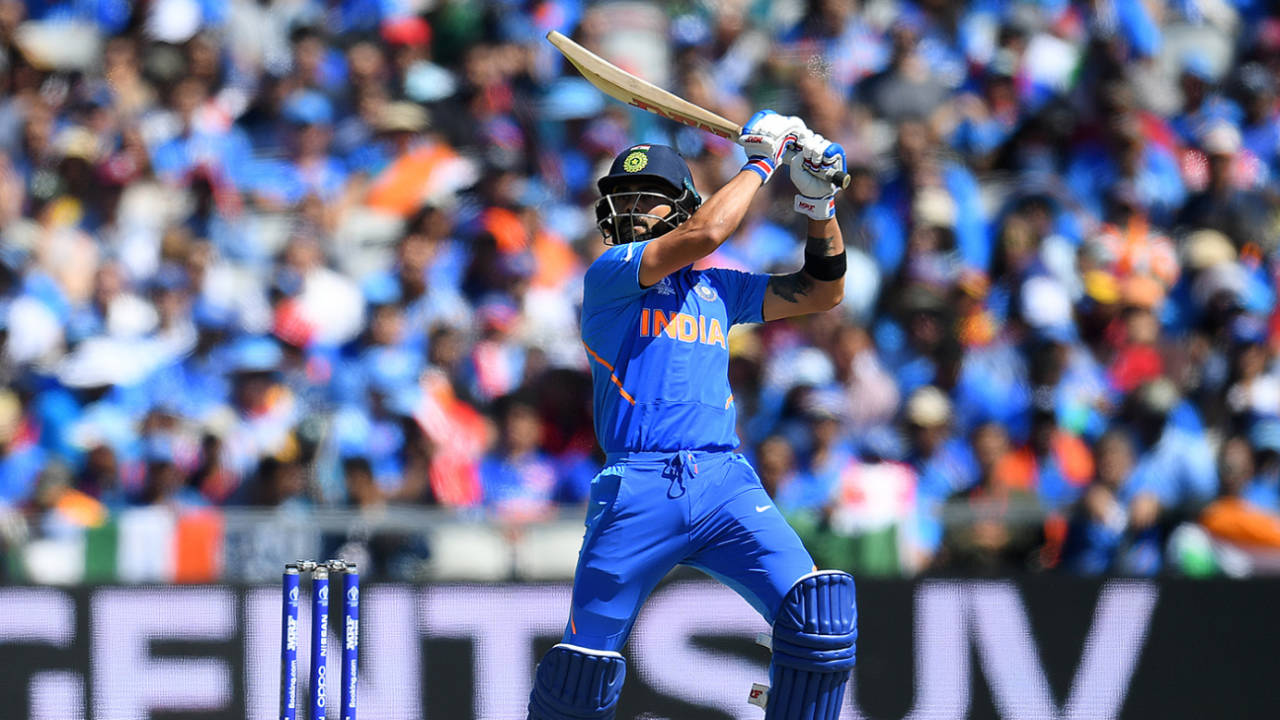The sounds of watching Virat Kohli bat
Kohli has yet to make the defining hundred of India's World Cup but his contributions have been no less significant
Sambit Bal at Old Trafford
28-Jun-2019
It's the sounds, as much as the sights, which set Virat Kohli's batting apart • Getty Images
Few sounds are sweeter in sport than bat on ball. If you have played cricket yourself, you know the rich, velvety feeling of instant well-being, the bat feeling light in your hand, and the contact is not so much a collision between two hard objects as it is sweet union, the wood absorbing the impact of leather softly, and turning it into an ally. And the sound, sonorous and resonant, is the heartbeat of cricket.
And when the bat belongs to a master craftsman like Virat Kohli, it's like love. It cuts through every noise. It fills the stadium. It echoes in the chest of those in attendance. It's more than an aural thing. It's a feeling. Long after the moment is gone, you can close your eyes and feel its reverberations. I was glad that I left the comforts of the press box to watch him bat from stands.
You know the sound of the bat of a player at the top of their powers. Amidst the din - conches, trumpets, chanting and screaming - Kohli's bat sang. And from the sounds off their bats, you could decipher the difference between him and MS Dhoni. They batted together for just under ten overs for 40 runs. Of those, Kohli scored 21 from 25 balls, and Dhoni 17 from 32. From Kohli's bat came the crisp and crunchy sound of certainty, from Dhoni's came the sound of workmanlike toil, muffled, scratchy, with the ball travelling reluctantly, sometimes to areas not intended.
Within the space of a few balls the difference was demonstrably established. In the 34th over, Kohli waited enough to cut a ball, with the swoosh of the wrists, not that short in length, from the left-arm spinner Fabian Allen, between two fielders - backward point and straightish cover - posted to guard against the very shot. It went to the boundary in a flash. Twice in Allen's following over, Dhoni attempted to put similar balls away, but managed to squirt one to third man, and another to the right of point, both fetching him couples. In all, Kohli took Allen for 23 runs off 25 balls, whereas Dhoni managed 9 from 19.
When his bat had finished its arc, it was perpendicular to his shoulders, just as it would be after a ramrod straight drive, except it was facing midwicket, against the angle in the which ball had been struck
It hasn't been Kohli's World Cup yet. For a man who has owned the stage in ODI batting, he lies ninth in the list of most prolific batsmen to date, and for the most voracious of century makers, his highest score in this World Cup has been 82. But these are modest returns only by Kohli's own standards. He is India's second-highest scorer behind Rohit Sharma and, more vitally, it's around his batting that India have built their totals. After falling early against South Africa, his lowest score has been 67.
Against both Australia and Pakistan, when India put up their highest totals in the tournament, Kohli provided the security and the strike to the centurions who dominated the match. But the true appreciation of his performance, and his value to India, can be gleaned from the last two matches where scoring has not been that easy. His 67 against Afghanistan came at over a run a ball in an innings where the second-fastest strike rate among the top six was 76.47 (Kedar Jadhav: 52 in 68 balls). India looked poised for at least 270 while he was at the crease, but scored only 57 in the 14 overs after he was dismissed.
KL Rahul scored more runs in their partnership of 69 against West Indies - 38 against 30 - but it was Kohli who provided the thrust, scoring those runs in 37 balls against Rahul's 51, with one stroke in this phase establishing his genius. He had begun his innings with a boundary against Oshane Thomas, quickly sizing up a drop in length and cutting it between cover and point. A couple of overs later, with his innings only six balls old, the opportunity arose again. But the ball was a fraction shorter, marginally wider, and considerably springier, and Kohli met it earlier, with a vertical bat, somehow slicing it over cover.
When his bat had finished its arc, it was perpendicular to his shoulders, just as it would be after a ramrod straight drive, except it was facing midwicket, against the angle in the which ball had been struck; his front foot pointing down the ground, but the back foot within the crease, upper body leaning slightly backward, and the head turned in the direction of the ball, a picture of imperious majesty. Describe in the stroke in a sentence? Lofted drive to a short ball, but hit square. Don't try to make sense of it. Watch the replay.
His innings ended to another short ball. But this one got stuck in pitch, came slower and lower than anticipated, and Kohli, early into his stroke, dragged to the belly of the midwicket fielder. Kohli stared at the pitch in disbelief. It was an eternity before he would drag himself away, and it created the longest silence in the stands. The absence of sound was as profound as the sound off the sweet spot of his bat through the morning.
Sambit Bal is editor-in-chief of ESPNcricinfo @sambitbal
